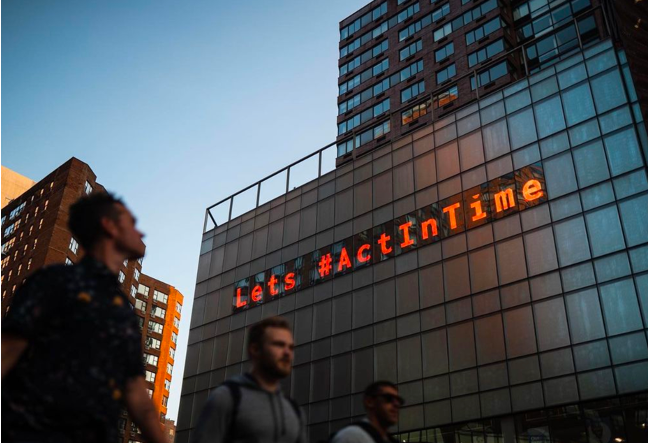Climate Clock: Live Countdown to the 1.5°C Warming Limit

The climate clock is ticking. It shows the estimated time left before global average temperatures rise more than 1.5°C above pre-industrial levels. This target is not simply a scientific milestone. It is a safety threshold that climate scientists agree is critical for avoiding the most damaging consequences of climate change.
The bad news is that we have only a few years left at the current rate of emissions. The good news is that we can slow the clock by acting together to cut greenhouse gases much faster than we are today.
Climate Change Countdown Clock
Below is the live climate clock, which tracks the estimated time remaining before the world warms 1.5°C above pre-industrial levels. It updates in real time using the latest data on global greenhouse gas emissions, showing how quickly we are using up the remaining carbon budget.
Why the 1.5°C Climate Limit Matters
Limiting warming to 1.5°C is a safeguard for people, nature and economies. Exceeding it will accelerate the breakdown of systems we rely on for water, food and health.
Rising global temperatures increase the risk of:
- Severe and more frequent extreme weather including longer droughts, intense flooding and stronger winter storms
- Reduced crop yields and food supply disruption leading to greater threats to food security
- Prolonged and dangerous heatwaves that affect health, productivity and vulnerable communities
- Significant biodiversity loss from coral bleaching to habitat destruction
These impacts are connected. More extreme weather can damage harvests, which in turn disrupts supply chains and increases economic instability.
Global Pledges and the Race to Net Zero
Nations have agreed to reduce greenhouse gas emissions and pledged to limit their emissions to ‘net zero’ by 2050. Despite the promises, it’s not happening fast enough. We only have a few years left before global warming reaches 1.5ºC, and based on the current lack of speed in moving to net zero, in all probability we will exceed this global red line by the end of the decade.
Understanding the Global Temperature Average
The 1.5°C figure is a global average and not a uniform rise across all regions. Some areas such as the Arctic are already warming nearly four times faster than the world as a whole.
This uneven warming has serious consequences. Faster changes in the polar regions can trigger knock-on effects including rising sea levels from melting ice sheets, which threaten coastal communities worldwide.
The climate crisis does not start at 1.5°C and it will not end there. Every fraction of a degree prevented makes a difference to the impacts we will face.
The Science Behind the Climate Clock
The climate clock is based on the global carbon budget, which is the total amount of greenhouse gases humanity can emit before exceeding the 1.5°C threshold. This budget is calculated by the Intergovernmental Panel on Climate Change using advanced climate models and the latest data.
The countdown changes as emissions rise or fall. If global emissions drop significantly, the clock gains time. If they rise, the clock runs down more quickly.
How We Can Slow the Climate Clock
The solutions already exist. The challenge is to scale them quickly.
- Switch to clean energy such as solar power and offshore wind
- Protect and restore natural carbon stores such as forests, wetlands and peatlands
- Choose walking, cycling or public transport instead of car journeys whenever possible
- Reduce waste by consuming less and reusing materials to cut emissions from production
Individual actions are important, but the biggest results come from working together. Communities and local authorities have the power to implement large-scale solutions. Explore our 25 big local actions to find projects that can deliver measurable results where you live.
FAQs
What is the climate clock?
The climate clock is a public visual tool showing how much time remains before the average global temperature reaches 1.5°C above pre-industrial levels. It is calculated using the remaining carbon budget and the current rate of greenhouse gas emissions.
Why is 1.5°C such an important limit?
The 1.5°C limit matters because it represents a point where climate impacts become significantly more severe. At this level, the likelihood of extreme weather events, biodiversity loss and disruptions to food and water supplies increases sharply.
Are we on track to stay below 1.5°C?
Based on present trends, we are not on track to limit warming to 1.5°C. Without rapid and sustained cuts to emissions, the world could exceed this limit before 2035.
Does staying under 1.5°C mean we avoid all climate impacts?
No. The effects of climate change are already being felt today. Staying under 1.5°C reduces the severity and frequency of these impacts but will not eliminate them entirely.
What can I do to help keep warming below 1.5°C?
You can reduce your emissions through energy efficiency, low-carbon travel and dietary changes. Supporting local climate initiatives and encouraging leaders to act can greatly amplify your individual contribution.
Recommended from Carbon Copy
-

Copy These! 5 Big Local Ideas About Using Decentralised Energy
Communities around the UK are generating their own electricity - through solar, hydro and wind. But how can they ensure…
-
 Affordable Energy, Buildings & Places, Climate Action, Good Food, Greater Fairness, Health & Wellbeing, Less Waste, More Jobs, Strong Communities
Affordable Energy, Buildings & Places, Climate Action, Good Food, Greater Fairness, Health & Wellbeing, Less Waste, More Jobs, Strong CommunitiesCopy These! 5 Big Local Ideas About Creating A Community Hub
Learn how communities are reinvigorating once-forgotten spaces, to bring local environmental, social and economic benefits.
-

How to Choose a Sustainable Christmas Tree: Real vs Fake
As you’re gearing up for the festive season, the question of which Christmas tree to bring home might come up.…
-
 Food and Agriculture, Good Food, Greater Fairness, Health & Wellbeing, Less Waste, Thriving Wildlife
Food and Agriculture, Good Food, Greater Fairness, Health & Wellbeing, Less Waste, Thriving WildlifeCopy These! 5 Big Local Ideas About Creating A Food Partnership
We all need to eat, and a food partnership is a great way to create a stronger, more sustainable, more…